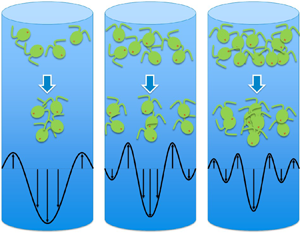Article contents
A sequence of transcritical bifurcations in a suspension of gyrotactic microswimmers in vertical pipe
Published online by Cambridge University Press: 03 September 2020
Abstract

Kessler (Nature, vol. 313, 1985, pp. 218–220) first showed that plume-like structures spontaneously appear from both stationary and flowing suspensions of gyrotactic microswimmers in a vertical pipe. Recently, it has been shown that there exist multiple steady, axisymmetric and axially uniform solutions to such a system (Bees & Croze, Proc. R. Soc. A, vol. 466, 2010, pp. 2057–2077). In the present study, we generalise this finding by reporting that a countably infinite number of such solutions emerge as the Richardson number increases. Linear stability, weakly nonlinear and fully nonlinear analyses are performed, revealing that each of the solutions arises from the destabilisation of a uniform suspension. The countability of the solutions is due to the finite flow domain, while the transcritical nature of the bifurcation is because of the cylindrical geometry, which breaks the horizontal symmetry of the system. It is further shown that there exists a maximum threshold of achievable downward flow rate for each solution if the flow is to remain steady, as varying the pressure gradient can no longer increase the flow rate from the solution. All of the solutions found are unstable, except for the one arising at the lowest Richardson number, implying that they would play a role in the transient dynamics in the route from a uniform suspension to the fully developed gyrotactic pattern.
- Type
- JFM Rapids
- Information
- Copyright
- © The Author(s), 2020. Published by Cambridge University Press
References
REFERENCES
- 5
- Cited by



